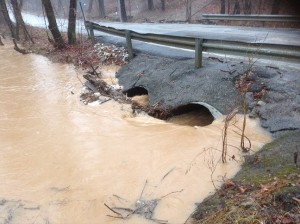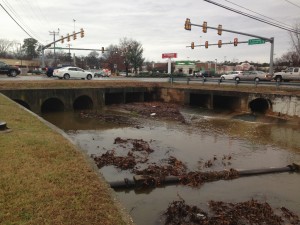
Finally. The snow is melting, temperatures are rising, and the green stems of spring crocuses are peeking through the mud in neglected gardens. The winter of polar vortexes and record snow days is receding. But all that winter snow has to go somewhere and eventually, that means local streams and rivers. In rural parts of the Chesapeake Bay watershed, forests and fields capture the snowmelt, remove pollutants, and reduce flooding. But in highly developed areas with lots of roads, parking lots and buildings, melting runoff rushes into sewers that feed directly into waterways, picking up oil, sediment, road salt and waste along the way.
According to a new report by the Chesapeake Bay Foundation (CBF), this suburban and urban runoff rapidly is becoming the Bay’s biggest pollution problem: It’s the only pollution source that’s projected to get worse, not better in coming years. (Other sources might be missing their reduction targets, but in most cases at least some progress is being made.) CBF blames the region’s suburban sprawl for the problem, which eats up open land at an astonishing rate. For example, between 1973 and 2010, Maryland’s population grew by 39%, but the amount of developed land jumped by 154%. By 2035, Maryland is expected to have a million more people and 500,000 new homes, meaning an even greater area will be covered by impervious surfaces that shoot runoff into streams and rivers, rather than allowing them to sink into the soil. Even now, CBF estimates that an area equivalent to a new Washington, DC gets paved over every four years in the Bay watershed. Development clears 25,000 to 36,000 acres of forest each year and, between 1985 and 2010, reduced farmland by 12%.

That area matters. CBF cites some powerful studies showing that as the amount of paved surface increases, aquatic life declines. For example, yellow perch stop reproducing when 10% of a watershed is covered. Brook trout disappear at only 2% and some amphibians die-off at 3% . In some cases, runoff kills the insects that creatures feed on. In others, the loss of tree shade makes water too warm. But it’s not just wildlife. Polluted runoff washing over pavement and overwhelming sewers brings bacteria in waterways that trigger beach closings and no swim advisories. It’s the reason why many miles of stream throughout the Bay watershed are considered “impaired” under the Clean Water Act, meaning they don’t meet water quality standards and can’t be used for some purposes.
We discussed some of the other dangers of stormwater runoff (such as contributing to the dead zone) in an earlier Downstream blog, along with some green infrastructure solutions for reducing it, such as rain gardens, green roofs and permeable pavements. In its recent report, CBF also recommends planting trees, constructing wetlands around development, and just plain old leaving more open space undeveloped. And they outline some specific policy initiatives in Virginia, Maryland and Pennsylvania that need greater attention – such as updating old municipal permits and stormwater management plans – while criticizing efforts to derail initiatives such as Maryland’s fee to control polluted runoff. Check out their report here to learn more about what’s going on in your state.
Sunshine and snowmelt traditionally signal springtime renewal; new life in our gardens, our forests and hopefully, with some thoughtful planning, our streams.

